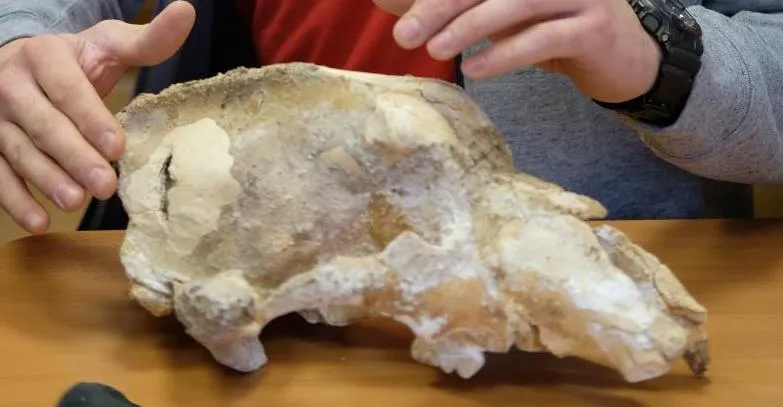This 35,000-Year-Old Skull Could Be the First Evidence of Humans Hunting Small Cave Bears
The hole in the specimen may have been from injuries inflicted with a spear or during a postmortem ritual
/https://tf-cmsv2-smithsonianmag-media.s3.amazonaws.com/filer/2b/d9/2bd908ca-a268-4887-906b-924647f72e60/267052_web.jpg)
During Siberian cave excavation, Russian paleontologists discovered the skull of a now-extinct small cave bear. Upon further examination of the skull, the researchers identified a small, long narrow hole towards the back that may have been caused by a Pleistocene human who speared the bear while it slept. The find could be the earliest evidence of ancient humans hunting small cave bears or possibly evidence of a postmortem ritual. The study was published in the journal Vestnik Archeologii, Anthropologii I Ethnographii.
During the late Pleistocene Epoch, small cave bears (Ursus rossicus) dwelled in caverns throughout Northern Eurasia. Around the same time, caves were also inhabited by Homo sapiens hunters who moved into Northeastern Siberia 30,000 to 35,000 years ago. It is not uncommon to find artifacts from ancient humans along with Pleistocene bear bones.
Paleontologists found the skull near evidence of human occupancy during three years of excavations in the Imanay Cave located in the Southern Ural Mountains, reports Issac Schultz for Gizmodo. Using growth layers on the bear's skull, the researchers dated the remains at about 35,000 years old and concluded that the cave bear was an adult around ten years old when it died.
Scientists also found various bone fragments belonging to mammoths, cave lions, wooly rhinos, steppe bison and red foxes within the cave. It is known that Pleistocene era Homo sapiens hunted mammoths and other large mammals for resources. Previous genetic research has shown humans may have hunted large cave bears (Ursus spelaeus) to extinction. Still, the damage found on the small cave bear skull, if confirmed, might the first evidence of humans hunting a small cave bear, Gizmodo reports.

"The hole in the skull could be either natural or artificial," says study co-author Dmitry Gimranov, a senior researcher at the Ural Branch of the Russian Academy of Sciences, in a statement. "In the first case, for example, a stone could fall on the bear's head, or water dripped onto the skull during thousands of years. But this is highly unlikely. Most likely, the animal was killed by ancient people."
However, the hole in the skull could have also been made postmortem as a type of ritual practice. The bear's bones showed no marks from having its meat removed for food, and rituals were common during the era, reports Ruth Schuster for Haaretz.
"In the Paleolithic, ritual, sacred practices were widespread. Therefore, a hole in the skull could have been made after the death of the bear as a ritual practice. The facts of hunting for bears in general at that time are extremely rare," Gimranov says in a statement.
/https://tf-cmsv2-smithsonianmag-media.s3.amazonaws.com/accounts/headshot/gamillo007710829-005_0.png)
/https://tf-cmsv2-smithsonianmag-media.s3.amazonaws.com/accounts/headshot/gamillo007710829-005_0.png)